Day 5
Wednesday, 13 November
Mangahuia campsite to National Park Village and Turakina to a country graveyard (11 km)
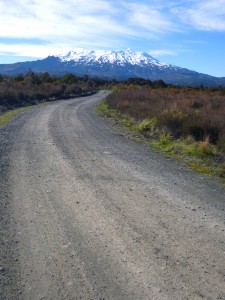 A thin layer of ice crackled off our tent as we unzipped it that morning. We put on our waterproofs for warmth and made coffee with some difficulty over a gas cylinder which sulked and spat. Ordinary gas doesn’t like sub-zero temperatures. The more expensive cylinders containing a different mix of gases always light and heat like a dream, so we’ll stick to those in future.
A thin layer of ice crackled off our tent as we unzipped it that morning. We put on our waterproofs for warmth and made coffee with some difficulty over a gas cylinder which sulked and spat. Ordinary gas doesn’t like sub-zero temperatures. The more expensive cylinders containing a different mix of gases always light and heat like a dream, so we’ll stick to those in future.
We walked along State Highway 47 from Mangahuia to National Park Village, where we were to catch the Intercity bus south to Turakina for the start of the Santoft Track. It was a singingly clear day and we kept turning to look back at the mountains.
Every now and again I get a rush of blood to the head, and go all didactic on my daughter. “We’re going to do vocabulary today,” I informed her, “it’ll enliven our road walk.” She could scarcely contain herself. “I’m soooo glad to be in school instead of walking in the wilderness,” she said sweetly. I am cruel, but fair. “For each word I teach you, you can teach me the meaning of a contemporary youth slang expression,” I offered. Deal!
“Vicissitudes,” I started. “It’s a noun!” she replied – brilliantly. Pffft. She gave up on the definition. My other words for her were entropy, apogee, quotidian, metafiction, septuagenarian and prurience. She confused entropy with atrophy and the only one she got right was septuagenarian, but I’m happy to report that she responded really positively to prurience.
Her list for me comprised dank, hipster, YOLO, snapback, swag and gains. “I’m giving you only the most basic words,” she explained kindly, “because you’re not ready for the more complicated ones.”
Me: Dank: Something damp and skanky, it could be a place that is wet, dark and horrid, like a dungeon.
She: Dank is a stoner’s word and a stoner is someone who smokes a lot of weed. Dank means really awesome or potent, for example, “Mmm that dank potato,” meaning “That really delicious potato”.
Me: Oh …. But potent and delicious describe very different qualities, although a liqueur could have both.
She: That’s what it means. You can’t question it logically. Now for hipster.
Me: A pair of trousers that…
She: Not the 1960s trousers version. Hipsters are people who act like they’re really cool because they “like something before everyone else likes it”, but in fact the majority of the population is the same way, so they’re not unique, they just think they’re unique.
Me: We-ell, we would call people “avant garde” if they liked something before it became fashionable. And “hip” meant “cool” way back when.
She: Yes, but hipsters don’t realise how pathetic they are.
And here are the other definitions. Gosh, the innuendoes are legion. Each slang term of my youth could be explained in about three words. Life is more complicated now. Or maybe it’s just more pretentious.
YOLO: You only live once, so you have an excuse to do stupid/dangerous/gross things and post them on the Internet so that they can ruin your future.
Snapback: A kind of hat that people called “swagfags” wear. Swagfags are male versions of hipsters. The hat is a kind of cap with a very stiff, round brim and a dome-like crown. It looks totally wuss.
Swag: Street-cred. A guy with swag will wear snapbacks (see above) and wear his jeans below his bum, and will walk around like he has something up his arse, because that’s “cool”.
Gains: A lifestyle in which you go to the gym, eat healthy shit and act like you are really tough, but made of seriously holier-than-thou stuff.
Now I know.
When we arrived at National Park Village we bought supplies at the petrol station and discovered that in this settlement, nothing at all happens between 9.00 am and sundowner time. Only one café is open for lunch; the rest offer breakfast and dinner to skiers. Many of the businesses are operated by local farmers as a second income, so they’ve got other priorities during the day. Residents are serious about litter, though. This is the only New Zealand place I have seen which provides a public rubbish bin every 40 metres on the street. Usually, you have to hunt for a bin.
We found a giant kiwi sculpture, made from uncut driftwood, next to the main road. It 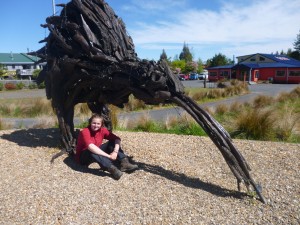 was fabulously assembled, especially its face. The eyes were natural holes in the wood and were uneven, because no two natural holes are the same. This created a rather measuring, speculative avian squint.
was fabulously assembled, especially its face. The eyes were natural holes in the wood and were uneven, because no two natural holes are the same. This created a rather measuring, speculative avian squint.
When we climbed off the bus at Turakina, it was after 5.00 pm and we had about seven kilometres of road walking before the beach trail began. After doing less than half the distance, we decided to stop. A fierce, grabbing wind had joined us and we knew it would make beach camping horrid. So … where to pitch Samson? The perfect place was a rural graveyard. We set up camp as discreetly as we could behind the church.
“Well, this is another first for you,” I said to Hannah. “Yesterday it was skinny dipping in the mountains and tonight it is sleeping in a graveyard. Clearly, your mother is providing you with a socially defective role model.” “Child protection services might want to remove me from your care,” she said (without any noticeable signs of distress). “Nah, I’ll argue that I’m teaching you career survival skills. You never know when you may wish to pursue a future as a vagrant or a vampire. A really dank one, that is.”
We had freeze-dried curried chickpeas for supper and slept early. The great benefit of our location, location, location was that the permanent campers were silent, so we had our first undisturbed sleep in four nights.
Day 6
Thursday, 14 November
Country graveyard to Brandon Hall Road (23 km)
We didn’t want to offend anyone, so we were more than usually careful about checking we left no evidence, not even a tiny shred of tissue paper, of our camp in the graveyard. Before leaving, we walked around, reading the headstones. Despite being a century old, it was a very small cemetery, but a couple of people had been buried there each decade. A mound of clay which had not yet settled showed how recently someone’s coffin had been lowered into the earth.
Children’s graves always pull at the heart but two headstones from 1915 had particularly poignant inscriptions. There was one for a 5-year-old boy. How wrecked his parents must have been; how reluctantly they must have surrendered his small body to the clay. Then there was a mass grave: a man aged 28 together with his four young children. What dreadful fate had overtaken them? Was it a house fire? Was it a family murder? The date is too early for the Spanish flu. Strangely, the four children are not named. I wonder why not? Maybe a cultural taboo was involved, or maybe there was insufficient money for a longer inscription.
I thought of how close Marius and I had come to losing both our children in 2012, one to physical illness and the other to the fallout of mental illness. Also of our friend, Tristan, a truly special man in the UK dying now of pancreatic cancer, and far too young to leave. Death and loss are at our shoulder all the time. If we obsess about these inevitabilities our lives are crushed. If we detach ourselves or are complacent, our lives have no savour. All we can do is use both hands to reach for the flashes of joy that fly before us.
The road to the Koitiata settlement is quiet. Only a couple of vehicles passed us that morning. We passed one, a small truck, parked on a farm verge. The keys were in the ignition and the engine was running. No-one was in sight. How extravagant. How trusting!
We heard a peacock meowling and saw a peahen fly heavily across the road ahead, landing among yellow-flowering shrubs. At first we thought these were more gorse, but they weren’t. There were no thorns and the flowers had a strong, soapy scent, something like gardenia.
Koitiata is a tiny village with about 100 residents. However, it is a place of seriously pissed off people. On every household’s fence were red or blue signs registering annoyance with the Rangitikei District Council. “Small town services; big town rates. Thanks RDC” or, “RDC rates rip-off zone”. It reminded me of South Africa, where in Hilton, during our last two years before emigrating, the council had put our rates up to match those of Sandton, the most affluent suburb in Johannesburg. We lived in a house with a septic tank, in a street without streetlights or a pavement. Wherever we go, we find likeness of being.
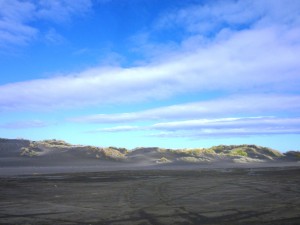 As we headed south on the beach, two women with their four dogs warned us we had chosen the wrong time to walk. “It’s high tide and you’re going directly into a head wind,” they said. The beach was amazing, though, well worth the rough going. I often wondered where artists found the driftwood for their massive sculptures, and now I know. Here is the ultimate tree graveyard.
As we headed south on the beach, two women with their four dogs warned us we had chosen the wrong time to walk. “It’s high tide and you’re going directly into a head wind,” they said. The beach was amazing, though, well worth the rough going. I often wondered where artists found the driftwood for their massive sculptures, and now I know. Here is the ultimate tree graveyard.
Trunks and branches, leached and weathered silver, contrast sharply with the black sand of the volcanic beach. Something about this coastline’s position and the angle of winds and tides conspire to capture the trees. Wood wrenched from its roots and washed down to the sea is cast back upon the black breast of New Zealand. And there it remains, like the bones on an ancient battlefield of giants where not a soul was left alive to bury the dead. 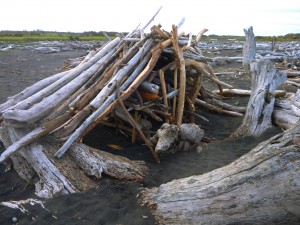 There are plenty of people who enjoy rearranging the remains, though. Children must have great fun playing here. We found two of their driftwood forts. These wooden ribs and vertebrae are definitely flashes of joy.
There are plenty of people who enjoy rearranging the remains, though. Children must have great fun playing here. We found two of their driftwood forts. These wooden ribs and vertebrae are definitely flashes of joy.
The dunes are bleak, partly colonised by the hardiest of grass which has its own kind of sheen against the sand. But such is the drive to live, even a tree uprooted far away and roughly replanted here by the sea, rallied and tried to grow again. Drawing on stored resources it could now never replenish, it pushed out hundreds of brave little shoots despite its forced removal to a place where it could never survive. I found its obstinacy, in the face of its certain extinction, strangely moving.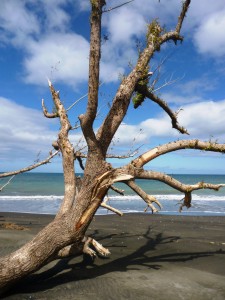
Leaving the shore after seven kilometres, we walked on forestry roads back towards the farmlands. Here, we heard more birdsong than anywhere other than at Wenderholm, and we also had the pleasure of seeing a hare with its brilliantly powerful hind legs and radar ears as it raced away among the trees.
Hannah was too tired to continue on to the settlement at Bulls, so we camped under the pines just short of the tarred road. The medication controlling her anxiety makes her unusually sleepy. It is something of an obstacle when we’re trying to complete a trail.
During the night, we heard some strange sounds. There was a scratchy, creaky call from some creature close to our tent, and from further away came noises that sounded like rusty industrial machinery going through its motions. It was some time before I realised these sounds were from cattle. Whoever invented the original onomatopoeic “moo” did not listen carefully enough. Moo simply does not do justice to the falsetto squeals, baritone drones and occasional howler monkey oohoos which these beasts can produce. So it was another disturbed night, but preferable to the sock saga of Dylan and Jocinda.
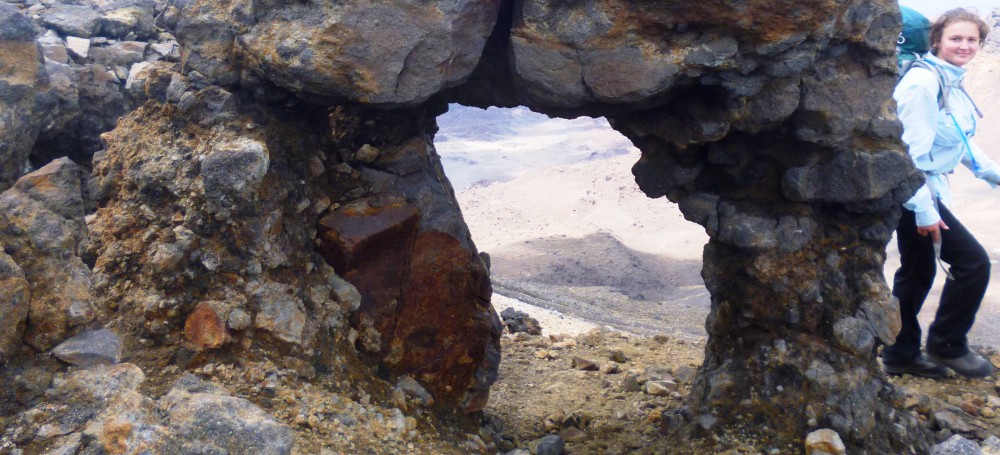
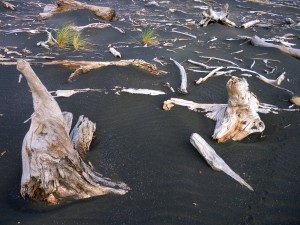
Not only do we get a lesson in geography, but my knowledge of the English language has improved. Looking forward to the next lesson. Keep up the good work.
oh my lessons and adventure, what is not to like. by the way is the sand on the beach black?
Yes, due to the type of volcanic rock that was pounded to sand in this area. I had not been on a black sand beach before, so I was thrilled. Up north the sand is very white and very fine.